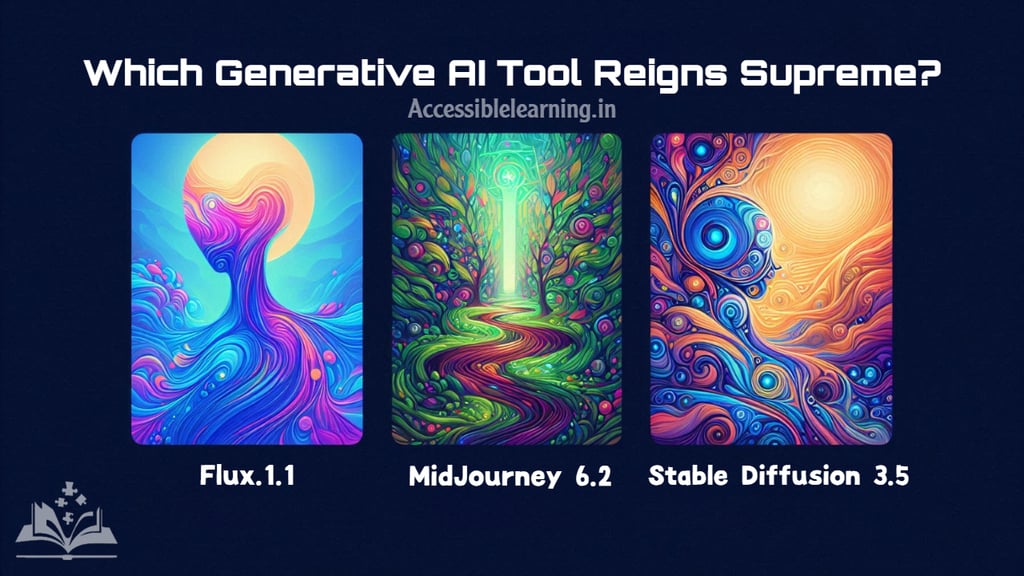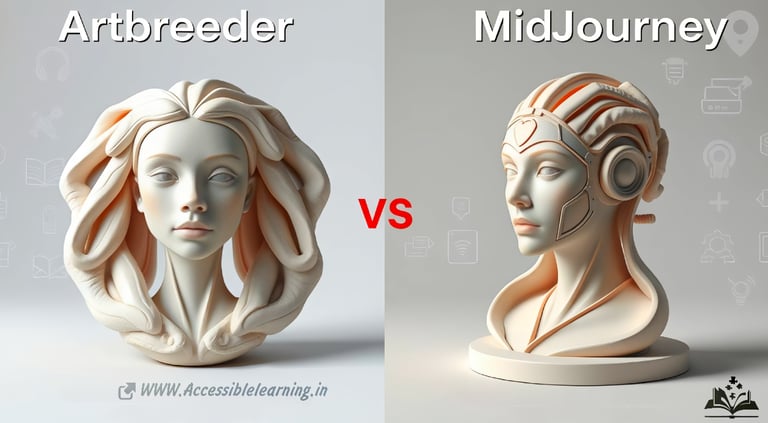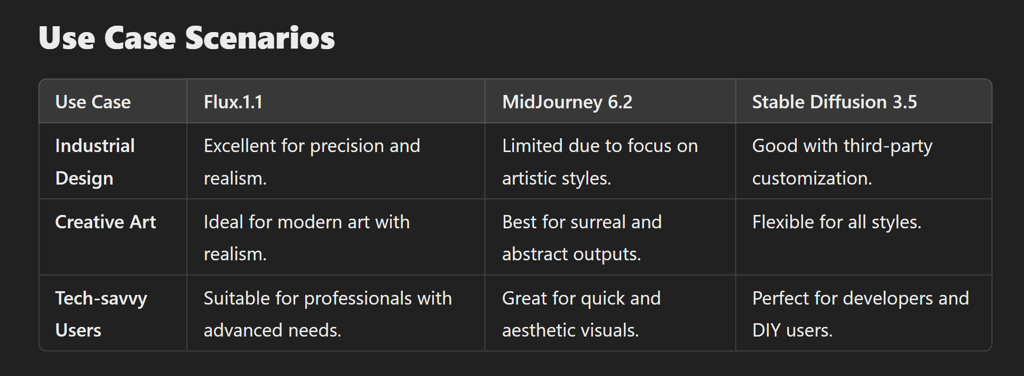
Choosing the Right Generative AI Tool: Flux.1.1, MidJourney 6.2, or Stable Diffusion 3.5?
Explore the ultimate comparison of Flux.1.1, MidJourney 6.2, and Stable Diffusion 3.5. Discover their features, strengths, and ideal use cases to find the perfect generative AI tool for your creative or professional needs. A must-read for designers, developers, and AI enthusiasts!
AI ART TOOLSEDITOR/TOOLSAI/FUTUREA LEARNING
Sachin K Chaurasiya
11/23/20245 min read


In the rapidly advancing realm of generative AI, three tools stand out for their creativity and innovation: Flux.1.1, MidJourney 6.2, and Stable Diffusion 3.5. Each has carved a niche in transforming how we approach digital art, storytelling, and visual content creation. This article explores the strengths, weaknesses, and unique features of these tools, helping you decide which fits your creative or professional needs best.
Flux.1.1
Flux.1.1 is the newest iteration of a generative AI tool designed for precision and adaptability. It is particularly suited for industries requiring high-fidelity visual outputs, such as architecture, design, and advanced visual storytelling.
Image Quality
Prioritizes hyper-realism, offering detailed textures, accurate lighting, and natural aesthetics.
Ideal for industrial designs and photorealistic projects.
Customization & Control
It comes with advanced sliders and node-based controls, enabling minute adjustments for professional users.
Offers enhanced prompt refinement for precision.
Speed & Performance
Optimized for high-performance systems.
May require robust hardware to operate at its full potential.
Cost & Accessibility
Targeted at enterprise users, with higher pricing tiers that reflect its premium features.
May not be budget-friendly for casual users.
Community & Ecosystem
A growing ecosystem, though it lacks the vast open-source community of Stable Diffusion.
Strong support for industry-specific use cases.
Pros
Superior realism.
Advanced customization options.
Industry-specific optimizations.
Cons
High cost.
Steeper learning curve.
Underlying Technology
Built on a proprietary architecture designed for precision-driven neural rendering.
Focuses on industry integration, such as CAD workflows or architecture tools.
Uses advanced techniques for multi-layered composing, allowing creators to manipulate intricate details like reflections, shadows, and textures dynamically.


MidJourney 6.2
Known for its artistic prowess, MidJourney 6.2 continues to be a favorite among artists and designers. Its emphasis on creativity and abstraction makes it a powerful tool for crafting surreal and imaginative visuals.
Image Quality
Excels in artistic interpretation, producing dreamy, abstract, and surreal visuals.
Favored for concept art and creative projects with high aesthetic demands.
Customization & Control
It uses intuitive commands for customizing styles, but it is less granular than Flux. 1.1.
Tailored for quick experimentation rather than meticulous adjustments.
Speed & Performance
Operates on a cloud-based system, ensuring consistent performance without local hardware dependency.
Cost & Accessibility
Offers affordable subscription models, making it popular among hobbyists and professionals.
Cloud access reduces upfront costs.
Community & Ecosystem
Thrives on a creative community that shares ideas, styles, and artwork.
Offers community contests and showcases for artists.
Pros
Exceptional for abstract and creative work.
Intuitive and user-friendly.
Affordable subscription.
Cons
Limited customization.
Cloud dependence may slow processes under high demand.

Stable Diffusion 3.5
Stable Diffusion 3.5 builds on its open-source legacy, providing flexibility for developers and creators alike. It balances technical customization with ease of use, making it accessible to a wide audience.
Image Quality
Offers a mix of realism and stylization.
Capable of producing balanced outputs, from fine art to casual visual content.
Customization & Control
Leverages open-source flexibility, allowing deep customization through third-party tools or plugins.
Supports advanced scripting for tech-savvy users.
Speed & Performance
Runs efficiently on consumer-grade GPUs, making it accessible even on modest setups.
Performance varies depending on the computational power of the user’s system.
Cost & Accessibility
Free to use under its open-source license.
Costs are limited to hardware and additional software if needed.
Community & Ecosystem
Backed by a massive open-source community.
Continuous contributions from developers result in a wide range of extensions and plugins.
Pros
Free and open-source.
Broad flexibility with plugins.
Accessible on most systems.
Cons
Requires technical knowledge for maximum benefit.
Image quality can vary without optimization.


Underlying Technology
Flux.1.1
Built on a proprietary architecture designed for precision-driven neural rendering.
Focuses on industry integration, such as CAD workflows or architecture tools.
Uses advanced techniques for multi-layered compositing, allowing creators to manipulate intricate details like reflections, shadows, and textures dynamically.
MidJourney 6.2
Relies on diffusion-based AI models with a strong emphasis on aesthetic transformations.
New in version 6.2 is the adaptive style engine, which intelligently interprets prompts for specific artistic eras, mediums, or creative trends.
Integrates seamlessly with cloud-based editing tools, ensuring easy collaboration for teams.
Stable Diffusion 3.5
Powered by an open-source diffusion architecture, allowing enthusiasts to modify the underlying code base.
Incorporates CLIP (Contrastive Language-Image Pretraining) for contextual understanding, ensuring better prompt adherence and realistic outputs.
Optimized for multi-platform deployment, from local servers to cloud instances.
Advanced AI Features
Prompt Engineering
Flux.1.1: Features a contextual feedback loop that suggests enhancements to prompts, ensuring fine-tuned results.
MidJourney 6.2: Known for its adaptive abstraction, capable of interpreting vague prompts and delivering artistic interpretations without requiring much user refinement.
Stable Diffusion 3.5: Supports highly detailed prompt crafting and offers compatibility with third-party prompt optimization tools, giving users unmatched control.
Model Training & Customization
Flux.1.1: Closed-source, but allows paid custom model training for enterprise clients needing domain-specific visualizations.
MidJourney 6.2: Does not support model customization but excels in pre-tuned artistic outputs.
Stable Diffusion 3.5: Fully supports fine-tuning and the creation of personal models using training datasets, ideal for creators seeking a specific style or niche output.
Ecosystems & Integrations
Flux.1.1
Integrates with professional tools like Blender, AutoCAD, and Unreal Engine.
Supports API connections for enterprise software ecosystems.
MidJourney 6.2
Accessible through Discord-based command inputs, making it social and collaborative.
Recently introduced beta browser access, expanding platform usability.
Stable Diffusion 3.5
Compatible with tools like Photoshop plugins (e.g., Stability for Photoshop) and DreamBooth for custom training.
Runs on platforms like Google Colab or local GPUs for cost flexibility.
Ethical Considerations
Flux.1.1: Focuses on enterprise-grade ethics, embedding compliance with IP and copyright regulations for commercial use.
MidJourney 6.2: Faces criticism for potential misuse in art theft but offers watermarking options for generated content.
Stable Diffusion 3.5: As an open-source tool, it’s more prone to misuse, but its community actively works on guidelines and protective measures like image fingerprinting.

Future Developments
Flux.1.1
Plans to expand into virtual reality (VR) and augmented reality (AR) pipelines, enabling seamless integration with immersive environments.
Expected to release AI-assisted texture mapping tools for video game developers.
MidJourney 6.2
Actively developing multi-prompt blending, allowing creators to combine multiple concepts in a single output.
Exploring integration with AI voice-guided art creation, making art generation even more accessible.
Stable Diffusion 3.5
The open-source roadmap hints at multi-modal capabilities, including text-to-video generation.
Upcoming releases may include native language support, broadening accessibility beyond English-based prompts.
Real-World Examples
Flux.1.1
Used by architectural firms to create hyper-realistic renders for client presentations.
Adopted by marketing agencies for high-resolution commercial ads that require precision.
MidJourney 6.2
Popular with independent artists for producing NFT artwork with unique aesthetics.
Employed by fashion designers to conceptualize experimental clothing lines.
Stable Diffusion 3.5
Leveraged by developers to design custom gaming assets and prototypes.
Adopted by educators for creating interactive visual aids in digital learning.
Expert Opinions
Designers on Flux.1.1
Flux.1.1 is an unparalleled tool for photorealistic projects, but its price and complexity may not appeal to casual users.
Artists on MidJourney 6.2
MidJourney inspires creativity like no other; its intuitive system makes art accessible even for non-technical users.
Developers on Stable Diffusion 3.5
Stable diffusion remains the king of customization. Its open-source nature is a goldmine for tech-savvy users.
Final Verdict
For industrial-grade precision: Flux.1.1 is unmatched.
For aesthetic exploration: MidJourney 6.2 remains a fan favorite.
For flexibility and control: Stable Diffusion 3.5 offers unrivaled versatility

Pro Tip: Beginners may prefer MidJourney 6.2 for its ease of use, while advanced users with technical expertise should explore the full potential of Stable Diffusion 3.5. If budget is not a constraint, Flux.1.1 is ideal for enterprise professionals seeking perfection.
Choose Flux.1.1 if you’re a professional or business focused on high-precision, photorealistic visuals.
Opt for MidJourney 6.2 if you’re an artist or designer prioritizing creativity and aesthetic appeal.
Go with Stable Diffusion 3.5 if you want maximum flexibility, cost-effectiveness, and the freedom to customize.
Each tool brings unique strengths to the table. Your choice should align with your creative goals, technical expertise, and budget. With Flux.1.1’s precision, MidJourney 6.2’s artistry, and Stable Diffusion 3.5’s flexibility, the possibilities are endless.
Subscribe To Our Newsletter
All © Copyright reserved by Accessible-Learning Hub
| Terms & Conditions
Knowledge is power. Learn with Us. 📚


